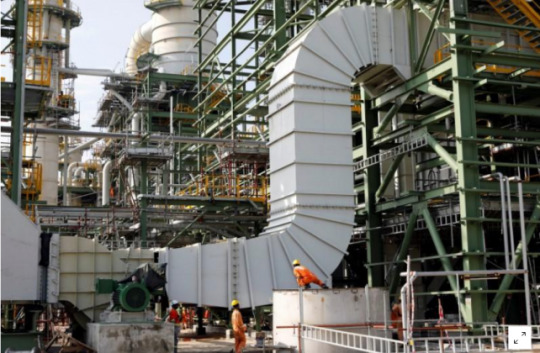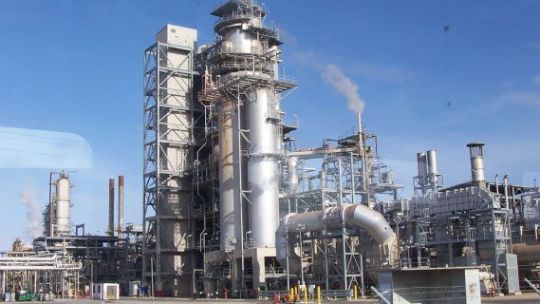#petrochemical industry
Link
The average liter of bottled water has nearly a quarter million invisible pieces of ever so tiny nanoplastics, detected and categorized for the first time by a microscope using dual lasers.
Scientists long figured there were lots of these microscopic plastic pieces, but until researchers at Columbia and Rutgers universities did their calculations they never knew how many or what kind. Looking at five samples each of three common bottled water brands, researchers found particle levels ranged from 110,000 to 400,000 per liter, averaging around 240,000 according to a study in Monday’s Proceedings of the National Academy of Sciences.
These are particles that are less than a micron in size. There are 25,400 microns — also called micrometers because it is a millionth of a meter — in an inch. A human hair is about 83 microns wide.
Previous studies have looked at slightly bigger microplastics that range from the visible 5 millimeters, less than a quarter of an inch, to one micron. About 10 to 100 times more nanoplastics than microplastics were discovered in bottled water, the study found.
Much of the plastic seems to be coming from the bottle itself and the reverse osmosis membrane filter used to keep out other contaminants, said study lead author Naixin Qian, a Columbia physical chemist. She wouldn’t reveal the three brands because researchers want more samples before they single out a brand and want to study more brands. Still, she said they were common and bought at WalMart. ...
#Environment#OMFG#WTAF#EVIL#plastics#pollution#petrochemical industry#microplastics#nanoplastics#bottled water
11 notes
·
View notes
Text

#petrochemical industry#plastic waste#recycling#environmental impact#public health crisis#fossil fuel companies#deception#corporate responsibility#environmental justice#pollution#plastic pollution#recycling limitations#economic factors#health risks#plastic recycling#public relations#lobbying efforts#recycling promotion#industry front groups#corporate strategies#circular economy#recycling research#environmental education#corporate awareness#sustainability claims
10 notes
·
View notes
Link
Excerpt from this story from Grist:
The petrochemical industry has spent the past few years hard at work lobbying for state-level legislation to promote “chemical recycling,” a controversial process that critics say isn’t really recycling at all. The legislative push, spearheaded by an industry group called the American Chemistry Council, aims to reclassify chemical recycling as a manufacturing process, rather than waste disposal — a move that would subject facilities to less stringent regulations concerning pollution and hazardous waste.
The strategy appears to be working. According to a new report from the nonprofit Global Alliance for Incinerator Alternatives, or GAIA, 20 states have passed bills to exempt chemical recycling facilities from waste management requirements — despite significant evidence that most facilities end up incinerating the plastic they receive.
Chemical recycling is an umbrella term that refers to a handful of different processes. The most common ones, pyrolysis and gasification, start by melting discarded plastics under high heat and pressure, either in a low-oxygen atmosphere (pyrolysis) or by using air and steam (gasification). Both processes produce an oily liquid that can technically be re-refined back into plastic. However, despite decades of experimentation, the petrochemical industry has never been able to overcome economic and technological barriers to do so at scale.
Instead, the fuel produced by most chemical recycling facilities ends up being burned — either onsite or after being shipped to cement kilns and waste processors across the country. This allows companies to generate energy from the discarded plastic, but at great cost to the environment and public health: According to one recent investigation from the nonprofit Natural Resources Defense Council, a single chemical recycling facility in Oregon produces nearly half a million pounds of benzene, lead, cadmium, and other hazardous waste per year, along with hazardous air pollutants that can cause cancer and birth defects. The report also found that, of the eight chemical recycling facilities currently operating in the U.S., six are located near communities whose residents are disproportionately Black or brown. Five of these facilities are primarily “plastic-to-fuel” operations, two are turning plastic into chemical components whose end uses aren’t disclosed, and one claims to be turning carpet into nylon.
29 notes
·
View notes
Text
Mukesh Ambani — Founder And Chairman, Reliance Industries
Mukesh Ambani is the founder and chairman of Reliance Industries Limited, India’s most valuable company by market capitalization. He is also one of the richest people in the world, with a net worth of over $90 billion.

Ambani was born in 1957 into a Gujarati Hindu family in Aden, Yemen. His father, Dhirubhai Ambani, was a textile merchant who founded Reliance Industries in 1966. Ambani studied chemical engineering at the University of Mumbai and then earned an MBA from Stanford University.
After graduating from Stanford, Ambani joined Reliance Industries in 1981. He played a key role in the company’s diversification from textiles into petrochemicals and refining. Ambani also led Reliance’s expansion into new businesses, such as telecommunications and retail.
In 2002, after the death of his father, Ambani became the chairman of Reliance Industries. Under his leadership, the company has continued to grow and diversify. Reliance Industries is now one of the largest private sector companies in India, with interests in a wide range of industries, including petrochemicals, refining, telecommunications, retail, and renewable energy.
Ambani is a visionary leader who is known for his bold business decisions and his relentless focus on innovation. He is also a strong advocate for Indian industry and for the country’s economic development.
Here are some of Ambani’s key achievements:
He led Reliance Industries’ diversification from textiles into petrochemicals and refining, making it one of the largest petrochemical and refining companies in the world.
He launched Reliance Jio, India’s largest telecom operator, which has revolutionized the telecom industry in India.
He launched Reliance Retail, India’s largest retailer, which has modernized the retail sector in India.
He is investing heavily in renewable energy, with the goal of making Reliance Industries a global leader in this sector.
Ambani is a respected business leader and a philanthropist. He is also one of the most influential people in India.
#Mukesh Ambani#Reliance Industries#Indian business leaders#Petrochemical industry#Telecommunications
0 notes
Text




The Dangote Refinery is an oil refinery owned by Aliko Dangote that is under construction in Lekki, Nigeria. When completed, it is expected to have the capacity to process about 650,000 barrels per day of crude oil, making it the largest single-train refinery in the world. The investment is over 25 billion US dollars.
0 notes
Text
0 notes
Link
The petrochemical industry is responsible for creating many products we use daily. Its primary product is petroleum, but some chemical compounds can also be obtained from other fossil fuels or renewable sources. Here are some of the chemical products made from petroleum.
0 notes
Text
HOT TAKE!
Oil is Haram
#oil is haram#oil industry#petroislam#petroleum#petrochemicals#petrodollars#oil money#greed#capitalism#anti capitalism#revolutionary islam#progressive islam
4 notes
·
View notes
Text

Found via Union of Concerned Scientists
5 notes
·
View notes
Text
"A video I made with my good friend professor Steve Hydrocarbon, about our misunderstood friends in the petrochemical industry."
#petrochemical#industry#gold#oil#drugs#gas#climate change#climate crisis#climate action#climate emergency#climate and environment#pollution#pollutants#polluted water#exxonmobil#ausgov#politas#auspol#tasgov#taspol#australia#fuck neoliberals#neoliberal capitalism#anthony albanese#albanese government#eat the rich#eat the fucking rich#global warming#ecology#econotego
9 notes
·
View notes
Text
Heaps of pharmaceuticals, toxic chemicals found in recycled plastics
The largest class of chemicals found were pesticides, with 162 chemical compounds coming from this category. Second in the list were 89 different pharmaceuticals. Third place went to 65 different industrial chemicals. These were followed by other classes of chemicals including surfactants, stimulants, fragrances, dyes, repellents, corrosion inhibitors, and more. In all, the researchers say that "491 organic compounds were detected and quantified, with an additional 170 compounds tentatively annotated."
Some of these chemicals come from the manufacturing of plastics themselves, while others are introduced during the recycling stage, and still others find their ways into the plastics through the process of adsorption, a process in which atoms of certain substances form a film that adheres to various surfaces. Because of the range of compounds found, the researchers say that they believe recycled plastics are unfit for most uses (...).

Published in Science
#plastic#plastics#recycling#environmental#chemical industry#chemistry#toxic chemicals#pesticides#pharmaceutical#hazard#health#industry#industrial#resin#petrochemical#petroleum#fossil fuels#research#published#peer reviewed#science#organic chemistry#organic chemicals#pollution#plastic pollution#material science#polymers#publication#epidemiology#public health
4 notes
·
View notes
Link
Excerpt from this New York Times story:
Louisiana activists battling to block an enormous plastics plant in a corridor so dense with industrial refineries it is known as Cancer Alley won a legal victory this week when a judge canceled the company’s air permits.
In a sharply worded opinion released Wednesday, Judge Trudy White of Louisiana’s 19th Judicial District in Baton Rouge noted that the residents in the tiny town of Welcome, where the $9.4 billion petrochemical plant would have been built, are descendants of enslaved Africans.
“The blood, sweat and tears of their ancestors is tied to the land,” Judge White wrote. “Their ancestors worked the land with the hope and dream of passing down productive agricultural untainted land along the Mississippi to their families.”
She said that when Louisiana state regulators granted 14 permits to FG LA L.L.C., an affiliate of the Taiwan-based giant Formosa Plastics, they had used “selective” and “inconsistent” data and had failed to consider the pollution effects on the predominantly Black community.
The decision is the latest in a string of blows to the proposed petrochemical plant. Those who have been fighting the plant said they hoped it would be the death knell.
The plant would be the world’s largest production facility for plastics and raw materials for plastics. It has been on hold since November 2020, when the federal government suspended a permit amid protests from local environmental groups.
12 notes
·
View notes
Quote
Nurdles have a significant impact on the environment long before they are formed, as well. The vast majority of the plastics plants in the United States are located alongside communities of color, which are disproportionately impacted by industrial pollution. Those plants emit a toxic mixture of pollutants including ethylene oxide, styrene, and benzene; there are so many petrochemical plants located between Baton Rouge and New Orleans that the area has become known as “cancer alley.”
Neel Dhanesha, ‘The massive, unregulated source of plastic pollution you’ve probably never heard of’, Vox
#Vox#Neel Dhanesha#Nurdles#United States#plastics plants#communities of color#industrial pollution#ethylene oxide#styrene#benzene#petrochemical plants#Baton Rouge#New Orleans#cancer alley
9 notes
·
View notes
Text
Understanding Commodity Plastic: Basics and Applications

Commodity plastic is a term frequently used in the plastics industry to refer to a group of plastics that are produced on a large scale and used in a wide range of applications. Understanding the basics of commodity plastic, including its properties and applications, is essential for anyone involved in the manufacturing or use of plastic products.
Exploring the Basics of Commodity Plastic:
Definition and Characteristics: Commodity Plastic refers to a category of plastics that are produced in high volumes and have relatively low costs compared to engineering plastics or specialty plastics. These plastics are characterized by their versatility, durability, and ease of processing, making them ideal for a variety of applications.
Common Types of Commodity Plastics: Some of the most common types of commodity plastics include polyethylene (PE), polypropylene (PP), polystyrene (PS), polyvinyl chloride (PVC), and polyethylene terephthalate (PET). Each type of commodity plastic has its own unique properties and applications, ranging from packaging materials to consumer goods.
Applications of Commodity Plastic:
Packaging: One of the largest applications of commodity plastic is in packaging materials. Polyethylene and polypropylene, in particular, are widely used for manufacturing plastic bags, bottles, containers, and packaging films due to their excellent barrier properties and flexibility.
Consumer Goods: Commodity plastic is also commonly found in a wide range of consumer goods, including household items, toys, kitchenware, and electronics. Polystyrene, for example, is used to make disposable cups, plates, and food containers, while polyvinyl chloride is used in the production of vinyl flooring and window frames.
Construction Materials: In the construction industry, commodity plastic is used for manufacturing a variety of materials, such as pipes, fittings, insulation, and siding. PVC, in particular, is a popular choice for plumbing and drainage systems due to its corrosion resistance and affordability.
Automotive Components: Commodity plastics play a vital role in the automotive industry, where they are used for manufacturing interior and exterior components, such as dashboards, bumpers, trim panels, and seating. Polypropylene, with its lightweight and impact-resistant properties, is a common choice for automotive applications.
Commodity plastic is a versatile and widely used material that plays a crucial role in various industries and applications. Understanding the basics of commodity plastic, including its properties and applications, is essential for manufacturers, designers, and consumers alike. By recognizing the versatility and value of commodity plastic, we can continue to innovate and create sustainable solutions for the future.
Get More Insights On This Topic: Commodity Plastic
#Commodity Plastic#Polymer#Petrochemical#Packaging Material#Plastic Production#Consumer Goods#Thermoplastic#Industrial Applications
0 notes
Text
1 note
·
View note